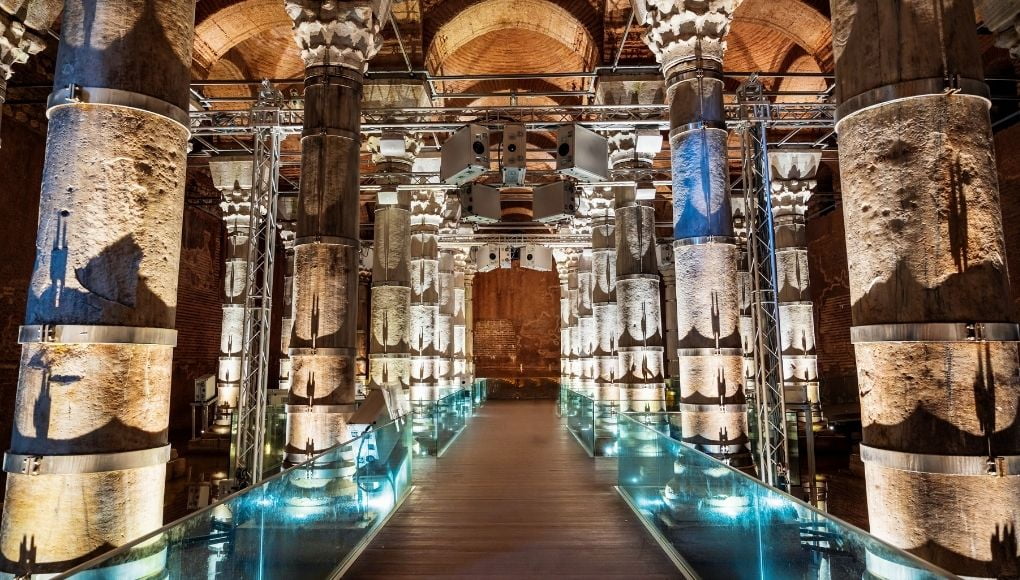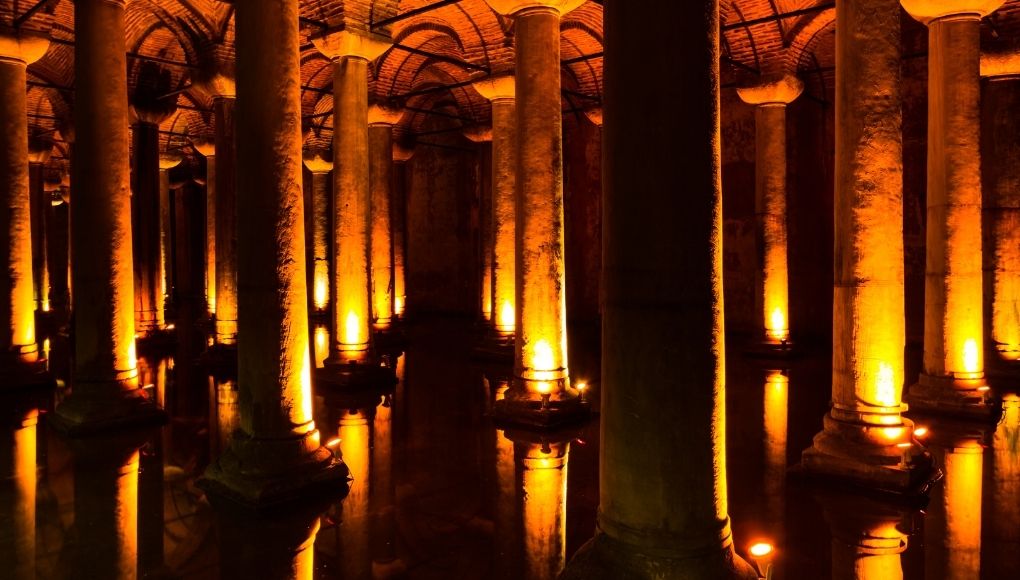The story of the Basilica Cistern is that it was built by the Eastern Roman Emperor Justinian I (527-565), designed for water storage. Also known as the Basilica Cistern, this gigantic underground structure was built in the city to provide water to the Great Palace and the buildings around it. According to written sources, the Basilica Cistern receives water from the Hadrianus Transmission Line, one of the historical waterways. Before starting our article, you can read our article about the holiday destinations you can enjoy in Istanbul.
Table of Contents
- 1 Where is Basilica Cistern Located?
- 2 How to get to the Basilica Cistern?
- 3 How Much Are Basilica Cistern Ticket Prices?
- 4 Can I Buy Basilica Cistern Tickets Online?
- 5 Is the Basilica Cistern MuseumCard Valid?
- 6 Information About Basilica Cistern History and Columns
- 7 What is the story of the Basilica Cistern Weeping Column?
- 8 What are the Legends and Stories of the Basilica Cistern?
- 9 The Story of the Basilica Cistern Medusa Legend
- 10 The Story of the Legend of the Rising Water in the Basilica Cistern
- 11 The Story of the Romantic Legend of the Basilica Cistern
- 12 Why was the Basilica Cistern built?
Where is Basilica Cistern Located?

The Basilica Cistern is an indoor water cistern located in Fatih Sultanahmet, known as old Istanbul. This structure, which attracts attention with its aesthetic and large structure, is visited by many local and foreign tourists.
How to get to the Basilica Cistern?
The Basilica Cistern, which hosts many tourists every year, is extremely easy to reach. Basilica Cistern is located in the Sultanahmet district of Fatih district of Istanbul. Basilica Cistern is also known for its proximity to Hagia Sophia Mosque and Blue Mosque. To visit the historical building, you can take the ferry from the Anatolian side and take the tram from Beşiktaş or Kabataş. Visitors on the European side can choose the Kabataş- Bağcılar tram line and walk 2-3 minutes after getting off at Sultanahmet stop.
How Much Are Basilica Cistern Ticket Prices?
Yerebatan Sarnıcı haftanın her günü 09.00-19.00 saatleri arasında ziyarete açıktır. 65 yaş üzeri ve 7 yaş altı ziyaretçilere girişler ücretsizdir. %70 ve üstü engelli ziyaretçiler ile refakatçileri için girişler ücretsizdir. Yerebatan Sarnıcı giriş ücreti 2023 yılında ise şu şekildedir: Tam Bilet: 50 TL Öğrenci- Öğretmen: 20 TL Yabancı (Turist) Ziyaretçi: 300 TL Ramazan süresince iftardan sonra 19.30- 22.00 arasında ücretsiz bir şekilde ziyaret edebilirsiniz.
Can I Buy Basilica Cistern Tickets Online?
Basilica Cistern entrance tickets are available for sale online from Passo. Visitors who purchase discount tickets online are required to show ID at the entrance. Tickets are valid until the closing time of the museum visit.
Is the Basilica Cistern MuseumCard Valid?
Since the Basilica Cistern is not affiliated to the Ministry of Culture, MuseumCard is not valid. Credit Card and Cash are valid. Foreign currency is not accepted.
Information About Basilica Cistern History and Columns

The Basilica Cistern is one of the most important cultural structures that preserve the remains of the magnificent history of Istanbul. It is also called the Basilica Palace because of the marble columns rising in the water and seemingly endless. It has 80,000 tons of water storage capacity, covers an area of approximately 1000 m2, is 140 meters long and 65 meters wide, and is a huge rectangular structure. So how many columns are there in the Basilica Cistern? There are 336 columns with a height of 9 meters, 2 Medusa heads, 52 steps stairs in the Basilica Cistern.
What is the story of the Basilica Cistern Weeping Column?
Over the years, as a result of the water collected in the Basilica Cistern and the materials used in the construction of the cistern mixed with the water, some columns were damaged over time. It caused the stone blocks on the columns to be displaced. The column was named the "Weeping Column" because the sounds emanating from the compressed columns were likened to the sounds of people crying. According to another rumor, it is said that there was an assassination attempt on Byzantine Emperor Justinian II and the captured assassins were tied to the Weeping Column and tortured. According to some, this column, which is called the Weeping Column because it is damp, represents the hundreds of slaves who died during its construction.
What are the Legends and Stories of the Basilica Cistern?
There are various legends and stories about every important and gigantic historical building. The most remarkable among the stories of the Basilica Cistern are the story of the Weeping Column, the legend of Medusa and the legend of the lost treasure.
The Story of the Basilica Cistern Medusa Legend
The Medusa heads, located under two columns at the very end of the cistern, are the statue that attracts the most attention of the visitors and even the statue that they wish and throw money. With the popularity of Medusa heads, rumors have emerged over time. According to the first Medusa legend, Medusa, who stood out with her beauty, fell in love with Zeus' son Perseus. It is also known that Athena, who was in love with Perseus like Medusa, was jealous of Medusa. Athena, out of jealousy, condemned her to eternal damnation and turned Medusa's long hair into a snake so that all the people who looked at her turned into stone. According to another legend, Medusa is one of the three Gorgonas, the female monsters of the underworld in Greek mythology. Medusa is known to turn those who look at her into stone. It is thought that Medusa was placed here for the protection of large buildings at that time.
The Story of the Legend of the Rising Water in the Basilica Cistern
According to legend, the Byzantine Emperor Justinian II is thought to have provided the water resources of the cistern through a tunnel to the Marmara Sea. It is said that Justinian II had the wall in the tunnel demolished and as a result of the collapse of this wall, the sea water flowed into the cistern and the cistern raised the water.
The Story of the Romantic Legend of the Basilica Cistern
The Basilica Cistern, a unique part of Istanbul's historical texture and water culture, is a popular place visited by many tourists. It is also known as one of the most romantic historical places. As much as its own history, the two Medusa heads inside it remain a mystery. How and for what purposes the Medusa heads were brought to the cistern is still a mystery.








































